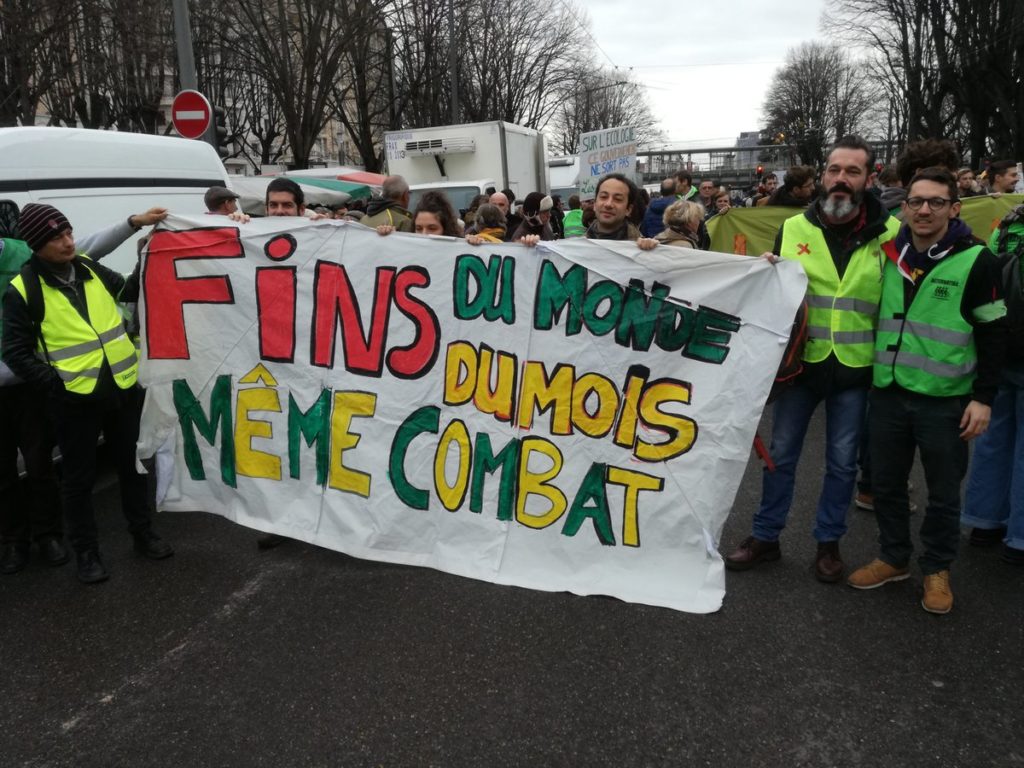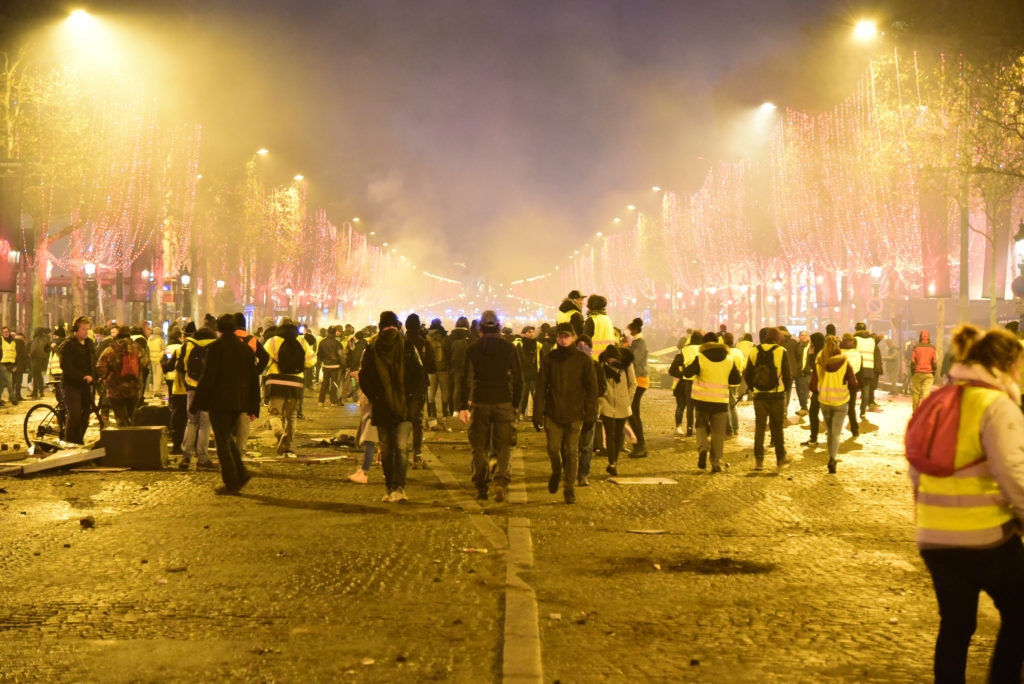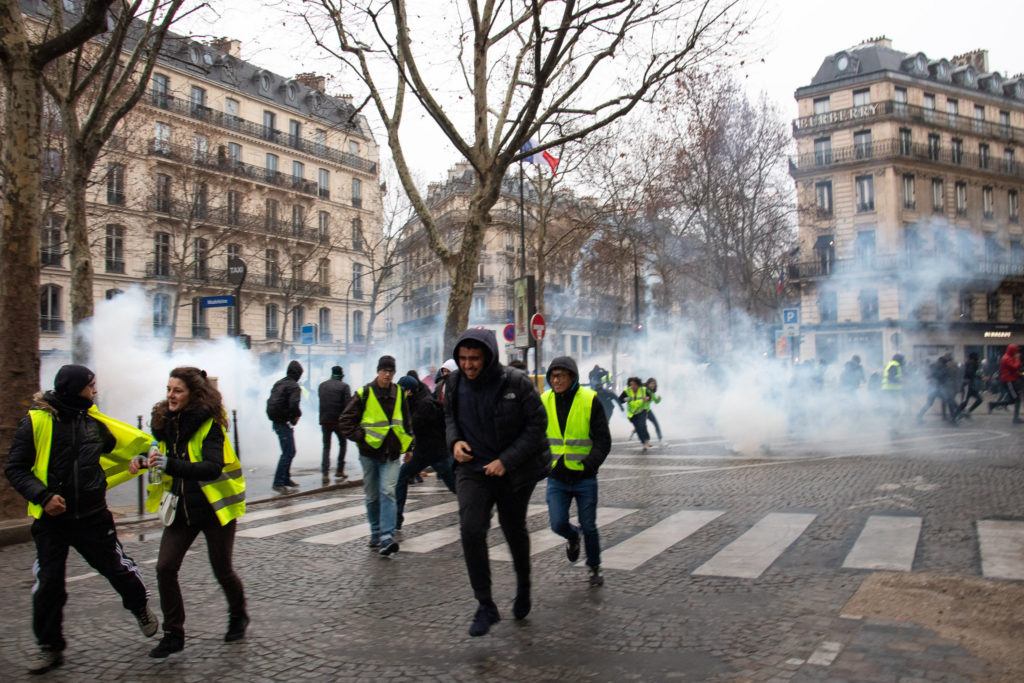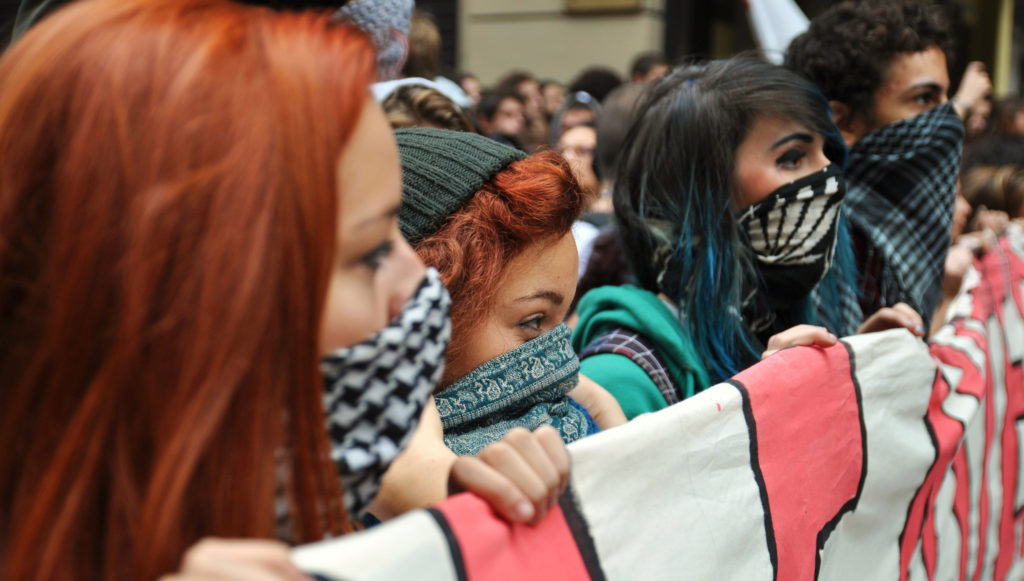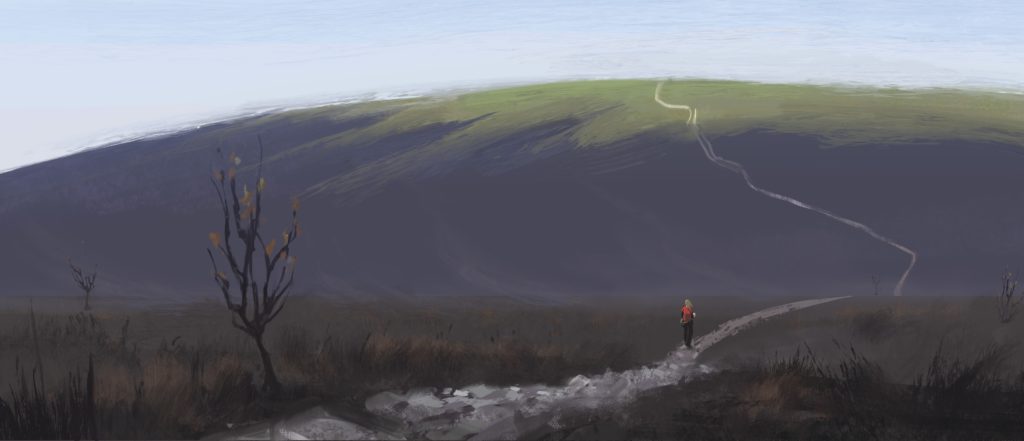
by Efflam Mercier
Alwena walked along the black scorched hillside of the Ménez Hom. In the distance, she could see dark clouds accumulating over the Crozon peninsula. The constant rain that used to be so emblematic of the region had become increasingly rare. Each droplet was a welcome relief.
As a mountain, Ménez Hom did not impress by its height, but by the fact that it completely dominated the landscape. One could stand at the peak and survey a large amount of the north-western French coast.
The Wehrmacht, having observed that during World War II, built a large radar and artillery base on the peak. The French resistance paid a heavy price to take it back from the fifteen thousand German soldiers sworn to defend it with their lives.
Alwena walked slowly over the small path of sandstone and inspected the fire damages. There had been fires before, but each year they were more frequent and destroyed more of the ecosystem. She remembered the landscape of peat and marshes, with wildflowers that added bright red and purple over brown like a painter’s brush on canvas. It was left dark and fuming now. Droplets of rain freckled her skin as the unpleasant smell of wet ash reached her nose. It wasn’t her first survey; the scent had become familiar.
A patch of colour caught her eye. Right in the middle of the devastated landscape, in the ruins of a bunker, Sundew was growing back. Alwena approached and reached down to examine the small red plant. She smiled at it. “Brave little one,” she said, “I don’t see any insects left to catch.”
After a few hours of searching for surviving plants by the mountain side, she noticed a pattern. June 11, 2043. Sundew survived on N flank but only near or inside bunkers, note: investigate passive cooling of concrete, she jotted down on her notepad with a pencil.
The wind picked up and ash flew into her eyes. It reminded her of tear-gas. She started to cough and cursed herself for not bringing a mask. She ran back to the surveyor’s van, trying not to trip among the spiky shrubs as the winds began to whip around her. The van was almost out of gas and not going anywhere, but it made for a perfect base for the surveyors. The sliding door opened and they shouted at her to get in.
When her eyes adjusted to the dim interior, she could see the faces staring at her.“You ok?” Wassim asked, handing her a wet towel. She looked for a clean corner and wiped her face and eyes with it. It came out grey.
“I’ll be alright. That came out of nowhere,” she replied, “Find anything interesting?”
“Some traces of a mudslide, heather and gorse is growing back, sphagnum moss isn’t. You know… the usual,” he said with a sigh, “How about you?”
“Somehow sundew survived, near the bunkers.”
“Who would have bet that out of all plants, sundew would outlive buckwheat.”
“I’m going to look into how that happened though, maybe what worked for the sundew can work for the wheat.”
“Maybe,” Wassim replied. She couldn’t tell if he was lost in thought or simply disinterested as he stayed silently looking out the window.
“What’s going on?” she asked.
“Uh…? Oh. I’m… I’m losing hope.”
His forced smile barely hid his despair.
“About the crops?”
“Yeah, I mean, the weather. One second it’s calm, the other there’s a storm. It’s probably what they felt like, in cities during the war.”
“What do you mean?”
“You’re waiting for the airstrike, it could happen any time so there’s no point in hiding in a bunker. Same for the storms, the floods. It could happen anytime. Life has to go on, but deep down you know. You’re at the mercy of the climate, and the climate is at the mercy of crumbling ideologies.”
Life has to go on, but deep down you know. You’re at the mercy of the climate, and the climate is at the mercy of crumbling ideologies.
As a Zadist, Wassim spent years trying to build anarchist utopias while being under constant threat of expulsion. He knew what it felt like to keep hope when things could end in an instant. He had been labelled an extremist when he blocked airports and oil pipelines from being built. Now, years later, throwing a wrench in the gears of civilization was the new norm for young people. Quite often Alwena would get swept up by her group of friends into more trouble than she signed up for. She grew up in a world where she saw the damages of climate change in the news. They were raised in a world where the school’s cantina occasionally served moldy EU humanitarian aid rations.
Another surveyor in the van spoke, “Yeah I’m struggling to see the light at the end of the tunnel here. I used to be an optimist like you, Alwena. I thought we could exit the system. Live on our own, demonstrate the alternative. But now with the floods and shitty soil, we can’t even do that anymore.”
Alwena took a deep breath. Outside of the van, the storm was raging. A small burned twig impacted the window and startled her.
“Guys, my optimism is fueled by the reality of the crisis. Yes, dozens of millions are going to die from famines, I know that. But when that’s done, the old world dies. I can guarantee you that we won’t be able to find a single person to defend industrial civilization when shelves and stomachs are empty. All we have to do is prepare to survive the next ten years.”
They waited for the storm to pass and rode bicycles down to the little town of Argol.
*
Alwena spent the next year down a rabbit hole to find out why the sundew survived in the bunkers. She obtained approval for the construction of multiple test greenhouses sunken ten feet deep in the limestone of the Ménez Hom. For Alwena, the way out was underground.

She walked down into the greenhouse and felt a strange satisfaction as she shut the door behind her. The carefully tended piece of microclimate was her pride. Many came to visit, perhaps to find hope. The fresh air almost made her shiver, or perhaps it was excitement. Many endangered flower species bloomed on the twenty meters of ground, while tomatoes grew on the side wall. The whole scene bathed in a serene and diffused sunlight.
The system was fairly simple and didn’t require any electricity. A few well-placed earth tubes would exchange warm air for cold using the massive thermal inertia of the mountain, smoothing out the sudden heatwaves. Alwena’s latest experiment was to tap into the cold air from the underground bunker complex. The structure of each greenhouse was twenty meters long but was almost invisible from the outside as it blended with the slope.
Alwena often called the greenhouse her “time-machine” for transporting crops to temperatures from before the Anthropocene. A time where scientists could still use radiocarbon dating to figure out the age of fossils. Alwena was still young, but the carbon isotopes in her bones appeared decayed, as if she were born nine hundred years ago.
She kneeled on a pad of wool and looked at the sensors. Temperature, moisture—she would record it all in a text file on her phone. Alwena angled the LCD screen towards the light to read the text better. “Phone” might be an overstatement—a mere hacked calculator capable of transmitting radio signals—but somehow it was so solid and the battery lasted for so long that she preferred it over anything else.
Just as she was about to finish reading all the sensors, she heard footsteps approaching.
“Is someone inside? We’re looking for Alwena Bihan,” a voice said from the outside. Through the blur of translucent plastic, she could see the silhouette of a man and a woman.
Alwena stood and opened the hermetic door. A camera and a notepad: news reporters. A large number of them showed up during the food shortages, but they soon lost interest in Alwena’s project.
“Yes?”
“We’re looking to get a few words from you about conservation efforts in light of the recent developments.”
“Sure… But first, get in there! I’m losing fresh air,” Alwena closed the door behind them.
The man threaded carefully through the plants to get both her and the reporter in the frame.
“What recent developments?”
“The construction of a phased array radar system on top of the Ménez Hom?”
“What… Why?”
The camera man lowered his camera, and the woman laughed nervously.
“We thought you would know. Since you’ve been so invested in the site. The radar and surface-to-air missiles will be part of the new nuclear security reinforcement program.”“So, do you want to comment about how the construction might affect the biodiversity of the Ménez Hom and your food security experiment? We’ve also seen a large mobilization of the green resistance on the internet after the announcement, what do you have to say about that?” She said, inching the microphone closer to Alwena’s face with every word.
“No, sorry. I need to think about it,” Alwena said, holding her head in her hand, “Please leave.”
Once the door closed, Alwena lowered herself to the ground. She had heard that countries throughout the world were boosting their anti-nuclear defense in preparation for famines. All the leading game-theorists said that it would end in threats of annihilation, or protection in exchange for food and oil. They said it could only result in the four biggest nuclear arsenal countries—France being one of them—dominating the flux of food and energy and escalating tensions. She didn’t think it would impact the Ménez Hom.
The vibration of her phone took her out of the storm in her brain. Wassim.
“Have you seen the news?” he asked.
“I heard it from some reporter who showed up just a second ago. It’s crazy. Does this have to do with L’Île Longue?” Alwena asked, fearing the worst.
L’Île Longue was the biggest stockpile of nuclear warheads and submarines in Europe, and it was right in her beloved peninsula.
“Exactly. The army wants to put some anti-air stuff, and an observation tower on top of the Ménez Hom.”
“Wait, it’s a protected site! I remember when I was a kid the regional government didn’t even authorize the army to install a mobile base for NATO exercises. How can they build a permanent base? That makes no sense.”
“Times have changed, I don’t think they care anymore. Countries with empty stomachs and an obese nuclear arsenal is not a good combo.”
“Also, are we talking about a local garrison or… the Cog?” She asked.
“The Cog, it’s the real stuff.”
Alwena’s head was spinning. What started as an ecological conservation experiment now put her in the centre of a massive conflict. Continuation of government or, as they called it, “The Cog” was both the boogeyman and the saviour. A plan originally designed to keep critical functions of the government running through any crisis. A plan that turned into a second government, operating in some secret bunker with no oversight. The Cog was always silent, but it sure kept the engine of the old civilization humming.
Continuation of government or, as they called it, “The Cog” was both the boogeyman and the saviour.
“So what’s your plan?” Wassim asked her.
“My plan?”
“Yeah. We’re not going to let the army build the base, are we?”
“I… I don’t know. Maybe Paris will see that prioritizing military security over food security is a self-fulfilling prophecy. But what can Paris really do?”
“But right now your thing is just an experiment, how many greenhouses do you have? Three?”
“Yeah three.”
“So we need to help you scale up then. It needs to become the embodiment of biodiversity, food security. Like a symbol, you know?”
“We?”
“The whole Zadist crew is talking about it, we’re ready.”
“Ready for what?”
“To make a stand, on the Ménez Hom.”
*
It didn’t take more than a week for word to spread, and soon Alwena was running around trying to explain to hundreds of Zadists how to build the greenhouses without harming the land. But that wasn’t why most people showed up. They showed up to defy the state’s authority once more, showing that another way of life was possible.
Alwena was torn, she resented Wassim for bringing all these people to the fragile landscape of the mountain. She changed her mind when someone working in l’Île Longue leaked the construction plans for the radar. They were going to dynamite entire parts of the mountain, drain out the marshes to make roads for armored transports.
Alwena had studied the plans and leaked photographs of the base, too. L’île longue was built on the side of a massive cliff, and the eastern side facing the Channel and the Atlantic was virtually indestructible granite. That also came at a big disadvantage; from inside the base, you couldn’t have a line of sight on enemy aircrafts coming from the west. The base was constructed before AI drones, assuming that a pilot couldn’t possibly fly below radar line of sight, or handle the g-forces from the hard turn required to strike the eastern side when coming from the west. This meant that enemy drones had a limited window to strike without being detected.
That was the flaw the Cog wanted to patch. The Ménez Hom had a line of sight over the entire peninsula, the perfect place to install surface to air missiles and radars pointed at the sea.
Alwena knew that none of that would save the country from starvation. The role of the Cog was to preserve the old world; its states, armies, and national identities. While many around her still believed in the concept of “the army” fueled by the passion of nationalism, for most people there was no choice but to feed the Cog in exchange for protection. More and more unemployed young men joined the military each year, when what the country needed was an army of farmers for the war effort of healing the land.
If they are going to destroy it all anyway, Alwena thought, might as well highlight the potential we’re losing.
She was surprised by how quickly the militants made caring about the mountain a social norm. Marginalized people who came to challenge the state stayed for the learning, food, and community. Alwena had always dreamed about this; a technological dystopia merged with a social utopia. The opposite of the world she resented.
Months passed in a blur, rhythmed by the attempted expulsions conducted by riot police. A trampled sign lay in the mud, it read “build farms, not nukes”. The riot police was ordered not to use tear gas or mortars up until that point.
Then came one day she could never forget. An early morning in August 2044.
*
The escalation of international nuclear threats eventually meant the end of roundtables and compromises. The Cog needed the mountain.
Alwena had heard rumors that local garrisons were ordered to finish the expulsions of militants and Zadists once and for all. Everyone shared one last beer and laughed nervously awaiting the deployment of more than five thousand men and armoured transport. This time, there was no way out.
One common tactic for Zadists was to chain themselves to a heavy object—a tree or metal pole—with handcuffs. She argued in vain with Wassim to not tie himself to that wooden beam. He tried to hand her the keys to the handcuffs but she refused, hoping that would dissuade him. Instead he gave the keys to a friend causing Alwena to instantly regret it.
“…Plus it’s stupid, they’ll just pull you off the beam and then you’re just handcuffed.”
“Good point,” he said, looking around him to people preparing for the expulsion, “Hey, you over here with the hammer! Mind nailing this plank up here?” he said, pointing to the top of the wooden beam.
Alwena stood there arms crossed while he was getting attached. Wassim was like the little brother she never had, always getting into trouble.
“Wait, where’s your mask?” Alwena asked, “You need to protect your eyes.”
“Oh shit, it’s in the greenhouse. Can you get it for me?”
Alwena instinctively dropped to the ground after hearing explosions in the distance.
“No time, take mine,” she said, fitting her gas mask onto his face.
“What about y…?” he tried to say before his voice became inaudible through the mask.
“I’ve got spare glasses,” Alwena said after taking out safety goggles from her vest, “They never use tear gas here, I should be fine.”
And before anyone could heed the screams of warning, mortars sprayed a barrage of tear gas canisters.
It all happened in a few seconds. Alwena groaned in pain as a rubber bullet hit her flank. She collapsed, out of breath under the impact. A canister fell near her and she saw the dry shrubs combust. Panicked, she looked side to side as she saw many more projectiles land in the shrubs. She ran towards the smoke grenades and threw her jacket over one of them to squelch the fire. She had begun to choke on the tear gas when sound grenades detonated.
Flashing images of heavily armored figures charged uphill and downhill in blinding coordination. It wasn’t just the police this time—the operation started with military precision.
She tried to look for Wassim but was already becoming disoriented. When her hearing finally returned, all she could hear were screams. Flames had quickly spread causing a wildfire that burned resistance and police alike. Those who chose to barricade themselves inside the greenhouses were caught in the fire and burned alive; others died after breathing the fumes of burned plastic. The finished greenhouses were completly fire-retardant, but many were in the middle of construction.
Alwena turned around and saw Wassim burning alive on his cross. She screamed as she was dragged away by the firefighters and handcuffed by the army. There was nothing she could do to save him. Neither the firefighters or the army managed to stop a small group of photographers from immortalizing the scene.
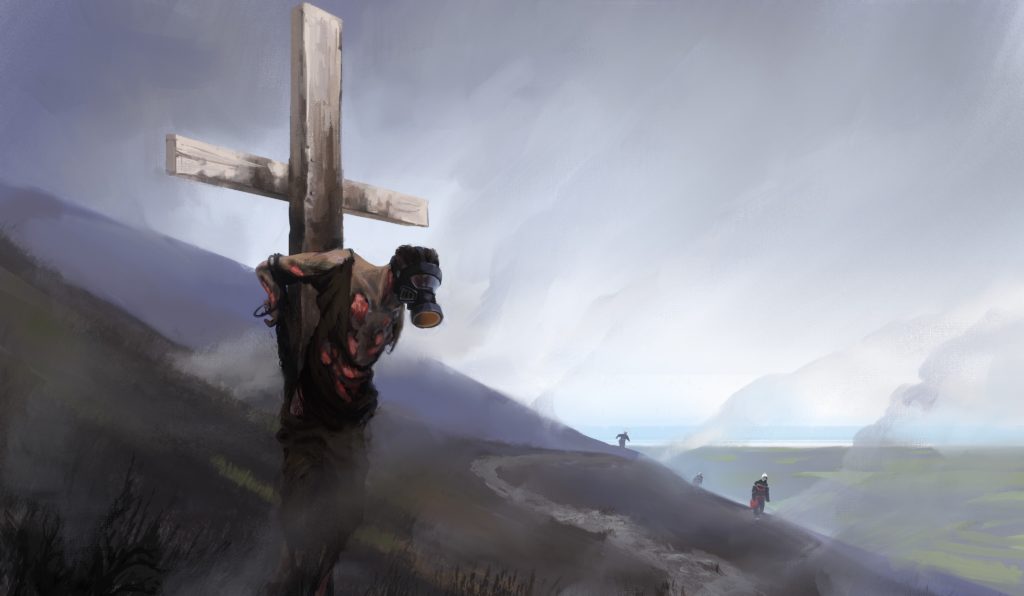
Alwena couldn’t witness any revolution from her prison cell, but she could hear it. The voices were loud, but that wasn’t enough to stop the Cog.
Then, the food simply stopped coming. Alwena heard it on the radio: A general food strike. All farmers would simply refuse to give, or sabotage any food meant for the military, even under threat of death. Any acts of brutality from the local garrisons or the Cog would paint them as they really were: a mafia at the nation scale, offering protection in exchange for food but destroying anyone who declined the deal.
Alwena ripped open the last emergency ration package with her emaciated hands when she heard the announcement that a garrison flipped. They made a deal with the local farmers: the garrison would continue to receive food, but in exchange they would receive orders from a citizen assembly and reject the Cog’s authority. One by one, not without its shares of skirmishes and scare-tactics, every unit, battalion, base, and vessel turned peacefully against their central command.
“Drink! This might be your last one” a guard said, his gaunt face startling her.
She took the glass and watched the bubbles.
“Champagne? Where did you find that?”
“It said ‘for a special occasion’ on the label, so we saved it until now,” the guard said with a faint smile crackling his lips.
“What’s the occasion?”
“We’ve been told there’s a submarine in the roadstead of Brest, with tactical nukes aimed at whoever flips.”
“…And?”
“We called bluff, so we’re flipping,” the guard replied, clinging his glass against hers.
*
Not long after that, she was free. A newly formed 6th republic built by Zadists and the food-strikers called for her help, to be a symbol against COGs and military rule in other countries, but first, Alwena wanted to see the Ménez Hom again.
A lot had changed in five months.
With streaks of burned earth barely visible under the layers of flowers, it seemed as if the surface of the mountain had already forgotten. The wind was ruthless and her locks were a tangly mess, but she felt alive. She placed blue thistles by a commemorative plaque. Red and blue wildflowers were scattered all around the base of a statue.
Wassim on the cross, a martyr in granite.
At the top of the Ménez Hom, between the earth and the sky, history had displayed the ability to repeat itself.
Granite remembered, as always.
*
In memory of my great-grandfather Jean Guennal, résistant on the Ménez Hom.
Efflam Mercier is a concept artist and writer with a passion for shining a spot-light on the effects of climate change. His upbringing in the French countryside of Brittany gave him a deep sense of responsibility to nature and its ecosystems. Efflam is currently working on a post-collapse painting series and resides in Los Angeles with his wife and two dogs.
All artwork by Efflam Mercier.
